- Home
- Where Palms Grow
- Can Palm Trees Grow Anywhere
Can Palm Trees Grow Anywhere?
We'll Guide You to Answers
Can palm trees grow anywhere is something many people are curious about. Bringing people to also ask where do palms grow naturally. And there is a difference between the two!
So do palm trees require a specific environment to thrive, or can they adapt to various conditions?
First, there are over 2,500 species of palm trees. Each has unique characteristics and environmental requirements. This diversity means that the answer to "can palm trees grow anywhere" is not a simple yes or no.
We'll scour the facts for where palms can grow, and alternately, where are they really suited for growth. We'll identify individual climates, places, and conditions where a range of palm tree species can be successful.
We'll indicate their adaptability, while asking you to consider specific needs.
Feeling overwhelmed by so many palm trees?
You're not alone. We Understand your headaches! At Mission: Palm Trees you'll find clear answers to questions & Step-By-Step Guidance, from real people. With solutions to help. No puzzling shoptalk. No tiring research. So it's easy & fun for you.
Understanding Natural Palm Tree Habitats
A very important fact to determine whether a palm tree can grow in a particular location is the climate. Let's first figure out Where Can Different Types of Palm Trees Grow?
Most palm trees prefer warm, humid environments with temperatures that rarely drop below 50°F (10°C). So they're native to tropical or subtropical climates.
They also need plenty of sunlight. Most species need at least six hours of direct sun per day.
Yet some palms can grow in temperate zones. These are more adaptable. But they may need protective care and extra attention. Especially when young, before they're established.
We'll show you natural habitats of palms, so you can tell if your climate is similar. Plus you'll see how to analyze growth requirements for their environment.
MAP OF TROPICAL CLIMATES & SUBTROPICS IN THE WORLD
Palms Growing in Temperate Non-Tropical Regions
While palms make people think of warm climates, they can be grown in less typical areas. Maybe you've seen a palm growing in a temperate climate. And that brought your question: Can palm trees grow anywhere? to mind.
While some palm trees can grow in temperate regions, they're not native to those areas. Many climate zones of the United States, including parts of Oregon & Washington State, are temperate.
Others Ask Can Palm Trees Grow Anywhere in the US?
Did you wonder about palms growing throughout the United States?
In colder temperate areas, like New Jersey & Tennessee some have grown palms. I've even heard of a palm growing in Wisconsin! Those types of Palms Need Added Attention. Especially when cold weather sets in.
Others have asked where in the world do Palm Trees Actually Do Grow, unexpectedly. We've seen some places you wouldn't even think of, like Germany & Norway!
So yes, many tropical plants, including palms, are growing outside their native zones.
Native Palm Trees Around the World
Many Palm Species are Native in numerous global regions. Naturally successful in climates well-suited for their growth.
So it's essential to recognize that the answer to asking can palm trees grow anywhere depends on their original habitats. Is the area you're thinking of, the climate, soil type, and available sunlight similar? Consulting with a local nursery or horticulturist can help you make an informed decision. You Can Also Ask Us> if a particular species might suit your location. Can the palm you've wanted adapt to your environment?
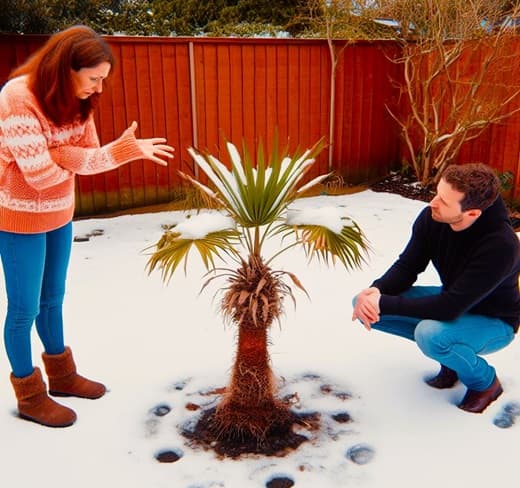 Will Our Palm Make It Through Our Colder Winters?
Will Our Palm Make It Through Our Colder Winters?Essential Care is Needed
No Matter Where Palm Trees Grow
Whatever the climate, palm trees need proper care to prosper. For the best Way Palms Grow. By starting with placing the right palm in the right place. For instance, our own palm was planted in its preferred environment. But what happened?! 🫤
FTC Disclosure: If you purchase via a link/ ad on this site, we may earn a small royalty. There's no added cost to you. Thanks much for any looks/ orders! Details>
Case Study:
A Palm Tree in Tucson, Arizona Has Problems
The True Story of our palm!
Only certain species of palms grow best where we live. That's in The Sonoran Desert in Tucson Arizona. We're within the subtropical climates of USDA zones. We Always Recommend A Visit!
Our acre lot was full of desert plants like saguaro & other cacti. Also creosote bushes which give a lovely scent when it rains.
Hubby Bill knew I loved palm trees. He surprised me with a birthday gift one year: a palm suited for the desert!
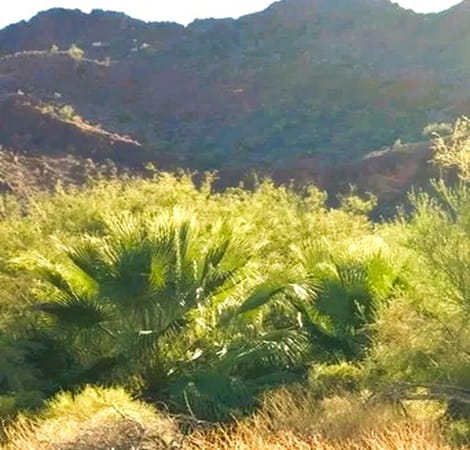 A Young Desert Fan Palm
A Young Desert Fan PalmAbout the Size Mine Was When we Left for California
It was a California Fan Palm, aka Desert Fan Palm (Washingtonia filifera). I planted it in our desert's well-draining soil. And began taking care of it. It was doing well.
A job opportunity soon prompted our move to San Diego in Southern California. We did love it there, palms growing everywhere, including at the Famed San Diego Zoo, which we definitely recommend!
We rented out our home. Asking the tenant (a retired woman) to take care of the palm. Giving her a break on the rent. Just water the palm once a week, we said.
Apparently she didn't do much. When we retired, arriving back to Tucson, that desert palm tree had died! She told us, "I'm not very good at taking care of plants, sorry."
That was my first experience with "hardy" palm trees going bad. Even though within its native habitat. That palm was not yet well-established. The basic, Proper Palm Care it needed was lacking.
How Environments Influence Palm Tree Growth
Three Considerations
There's more to think of when judging if palm trees can grow anywhere. This section covers additional circumstances, including temperature, drought, and sun.
1 Palm Tree Tolerance in Cold Climates
Think of the coldest temperatures an area experiences. Palm trees enduring temps below their tolerance can get Frost/Freeze Damage.
One well-know is the Chinese Windmill Palm (Trachycarpus fortunei). One of the most cold-tolerant palm species. It's known to survive temperatures down to 5°F/-15°C. Making it popular in climates like the Pacific Northwest or parts of Europe.
These are growing In Ontario, Canada...
2 How Drought Tolerant is This Palm Species?
Dry climates are dehydrating, even for palms. Some palm trees are Suited to a Desert Climate. Like this Very Unusual Desert Place where palms do grow.
- Rainfall in Arid Climates is only up to 10in/<25cm per year. Semi-arid areas (Tucson is this) average 10-20in/25-51cm of rain yearly.
- Consider your area's yearly rainfall & humidity if you're choosing a palm species.
- Some palm trees, like the Mexican Fan Palm (Washingtonia robusta), are well-suited to dry, desert climates.
3 Sunlight Preferences of Palm Trees
We think of palm trees loving sunny areas. And many do prefer sunny locations.
Species, like those native To Tropical Rainforests (We Highly Recommend This Experience), prefer full or partial shade. Because of that original habitat. Those species don't like hot, scorching full sun beating down on their fronds all day!
 Will That Blistering Summer Sun Give Your Palm Sunburn?
Will That Blistering Summer Sun Give Your Palm Sunburn?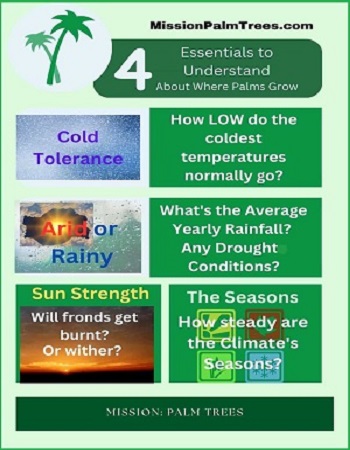
Can Palm Trees Grow Anywhere?
A Decision-Making 5-Step Guide For You
These pointers provide insights into choosing a palm species that's well-suited for your location. So you'll know how to pick the right palm for your area.
Keep this principle in mind: Plant the right palm in the right place!
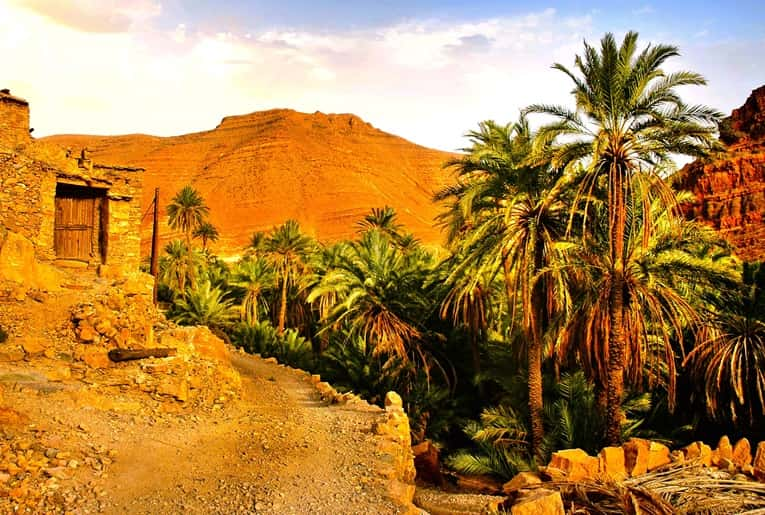 These Date Palms are Well-Suited to Their Desert Environment.
These Date Palms are Well-Suited to Their Desert Environment.In Fact Too Much Water Can Harm Them.
When Thinking: Can Palm Trees Grow Anywhere?
Know These 5 Points
Step 1 - Why you should think of elevation
Other influences affect winter's colder temperatures. Usually, the higher the elevation, the colder the lowest temps go. Even taking a climate from subtropical to temperate. So it's important to know the Local Hardiness Zone where a palm will be planted.
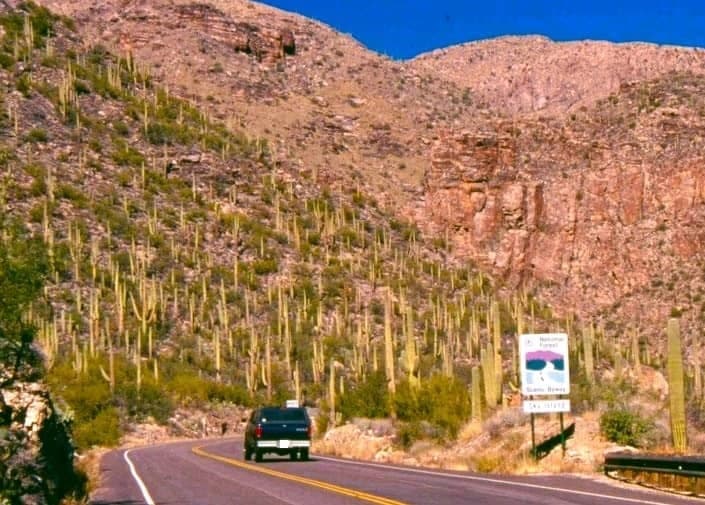 Beginning the Tucson Scenic Drive From ~3000ft/914m
Beginning the Tucson Scenic Drive From ~3000ft/914mWhere Desert Palms Could Survive
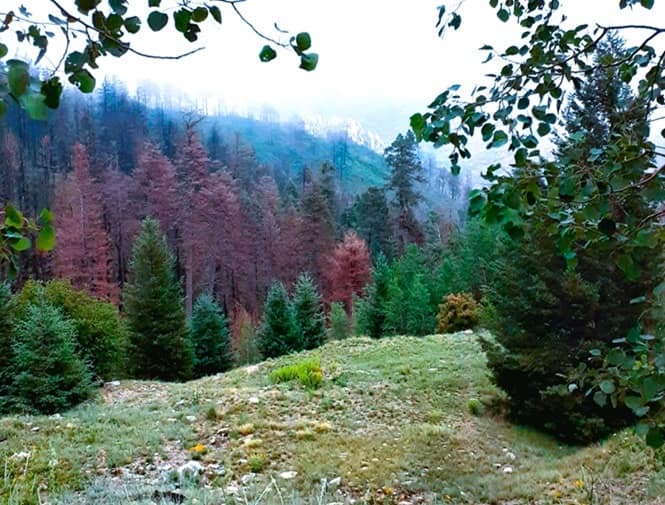 Driving 25 min. to this Pine Forest at 9000ft+/2743m+
Driving 25 min. to this Pine Forest at 9000ft+/2743m+Where No Palms Grow.
Step 2 - The Need to know, for cold tolerance
What are the lowest year-round average temperatures in any area? Understanding how the Hardiness Zone Evaluation Works helps you figure that out. Helping to know if a palm can grow somewhere.
Step 3 - Why you should know about rainfall
It's essential to know yearly rainfall in areas where palms will be planted. Plus knowing the Type of Soil in the planting area.
Water is crucial for palm tree growth. Most species need regular watering, especially during hot summers. Best to know the water needs of a palm species. So irrigation is scheduled accordingly.
EXCESSIVE RAINFALL
Too much rainwater can be harmful to many palms.
- If the soil is continuously and excessively moist, roots become water-logged.
- Well-draining soil is best for palms. They can struggle in heavy clay soils, which don't drain quickly.
- Were you thinking of growing a palm tree where there's poor soil? Amendments like sand, perlite and/or organic matter can improve drainage.
TOO LITTLE RAINFALL
On the other hand, is the area likely to experience drought? That's not good for many palm species.
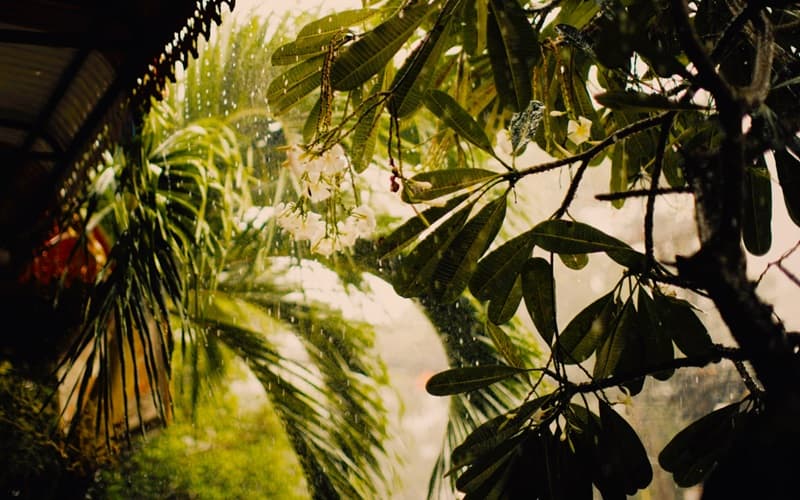 Will Lots of Rain Drain From the Palm Roots? If not, it Brings Chances of Fungal Root Rot.
Will Lots of Rain Drain From the Palm Roots? If not, it Brings Chances of Fungal Root Rot.Step 4 - Which sunlight setting is the best for Palms?
Most palms love sunny areas. Yet those species that originated in rainforests definitely don't! These will prefer partial or full shade.
It's important to know the native area for a palm. To consider if it doesn't want sunlight all day.
Step 5 - Why you should know about consistency
One final thing to evaluate is the particular seasons in an area. Related to Steps 1 though 4, is the weather mostly reliable? Are there frequent unexpected highs or lows in temperature? Are wild, unexpected storms arriving more frequently?
You'd want to know the average temps & weather for the area. Has it been mostly steady, or shifted around a lot? This can affect which palm is suited for specific places.
This overall assessment of the environment is key to predicting a palm's success - or not! To help you evaluate where palm trees do grow successfully. All for knowing the right palm is in the right place!
Can palm trees grow anywhere - takeaways to do
So, can palm trees grow anywhere? We can answer no. But palms are somewhat flexible.
While palm trees are often associated with the tropics, their adaptability and diversity mean that they can be grown in a wider range of locations than many people realize.
This guide gave steps and insights to having an appropriate palm grow well. By considering factors like temperatures, water needs, sunlight, and seasonal surprises.
Whether you're a seasoned gardener, a lover of tropical landscapes, or simply someone who appreciates the beauty and diversity of nature, the question of "can palm trees grow anywhere" is an invitation to explore the fascinating world of these iconic plants.






